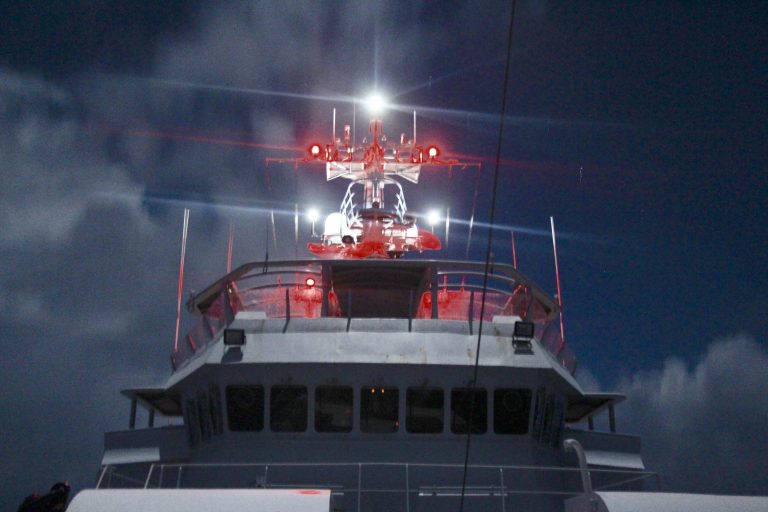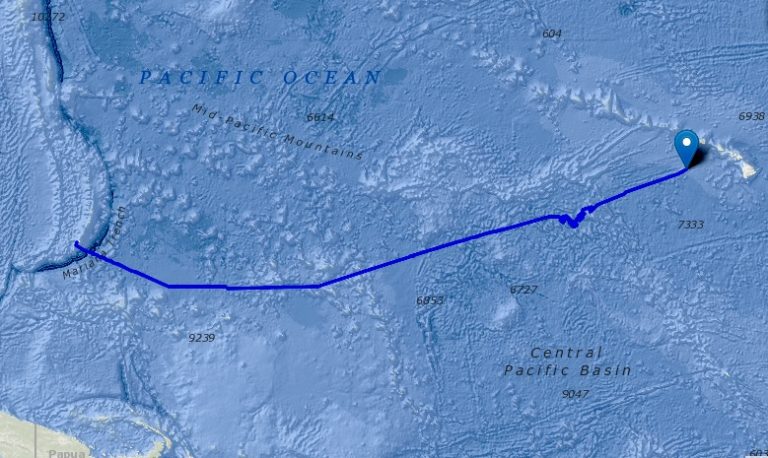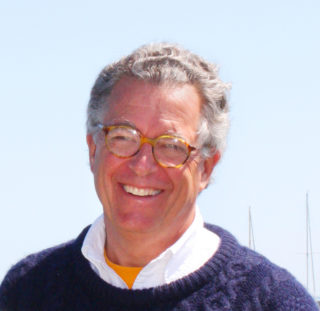This blog was written on Friday, January 13th around 3:30 in the afternoon. We are back on the western side of the International Dateline, so we are again on the same day as the Vineyard. A little before noon today we finished mapping six heretofore un-mapped seamounts in the southwest corner of the Johnston Atoll Marine National Monument and are now beginning the 800 nautical mile transit to Honolulu where we will disembark. There is a beautiful long four meter swell running from the Northwest with a relatively gentle trade wind blowing out of the northeast. The period (the time between the peaks of two swells) is over ten seconds which simply means this is a great ride on a beautiful afternoon.
Brock, Jr. and I with cameos by members of the crew and other outreach staff on board have done seventeen classes with not only Vineyard elementary and high school classrooms, but also classrooms in Maryland, South Carolina and the Dominican Republic. To see and hear the enthusiasm in these students and to be able to respond to their questions livestream has been wonderful. By the way don’t ever cut third graders short. Their energy and their enthusiasm were spectacular! We have also been integrally involved in the science on board, serving watches in the Science Lab, editing data that is being collected by the multi-beam sonar and backscatter imaging equipment. Talk about new skills and understanding!
Reflections
We were asked by one 9th grader, “What are some of the things that have surprised you?” I am not so sure anything has really surprised me, but here are some rambling reflections: The thirty-one of us on board have interacted seamlessly. The crew has been more than welcoming, participating with us in classes almost every day. The scientists have been patient while teaching us the skills necessary to actually be productive in the lab. Each of the other educators, artists, athletes and students have shared material and ideas with each other. We have only seen four other vessels during these three weeks, a container ship and “RoRo” bound for China and two Chinese fishing boats (late at night on radar). This kind of underscores how remote the waters we have transited are. There are not a whole lot of other folks out here. We have not yet seen any marine life other than a few flying fish and now quite regularly Boobies (birds). Hopefully, as we approach Hawaii we will see some whales as we would be entering an area where they breed and this is that time of year for them. The weather has really cooperated given the time of year. Lastly, we had to deal with a half knot foul current as we were easting during our initial passage out of Guam. In all likelihood it was a tradewinds-driven current but it could have been an equatorial counter current, although at a Latitude of 9° North probably not.
Takeaway’s
I have been asked a whole bunch of times by the crew, media representatives and 11th Hour Racing and Schmidt Ocean Institute representatives what my “takeaway” is. The short answer, “Wow, this has been an incredible experience!” But actually, the best takeaway is the result of an email I received this afternoon from a former Maritime Sciences student at MVRHS who is about to graduate from college. He is majoring in a subject that is not even remotely connected to the maritime industry, and he acknowledged that he has a significant post graduate obligation. Yet here we are almost four years after his graduation from MVRHS, and he was inquiring as to the existence of “fast track” programs that would help in his search for employment in the maritime field. What this email underscored for me is that we at Sail Martha’s Vineyard are having an impact on the lives of the young people with whom we work. That’s the whole reason behind everything we do. On a personal level I will return to the Vineyard with a whole new appreciation for the technical and scientific efforts that are being made to preserve and protect our oceans. What I have learned by having the opportunity to work with the scientists, crew and other teachers on board R/V Falkor is to how to better inspire young people as to the myriad of opportunities and experiences that await them in the marine sector and to have an even greater chance at having a meaningful and constructive impact on their lives.
The Science
I am delighted to report that the results of the ship’s scientific efforts have exceeded expectation with the weather cooperating and the ship’s crew showing extraordinary seamanship in anticipating and following the mapping track lines requested by Chief Scientist John Smith. Overall, we estimate that we have mapped approximately 9,000 to 10,000 square kilometers of seabed. There is no question that the technology that allows the scientists to pursue their goals is incredible, but it’s their perspective and innate understanding of the evolutionary timeline and processes of how this physical planet evolved that blows me away. They are hydrographers, geologists, mappers, code writers, technicians, and their command of their subject matter is a bit overwhelming. Plus, they are really nice people and as I have said before, great teachers.
Thank You
I would be remiss if I did not extend to 11th Hour Racing and the Schmidt Ocean Institute my greatest appreciation for their allowing me to participate in this expedition. As our Sustainability Partner, 11th Hour Racing has been an enthusiastic advocate for and mentor to Sail Martha’s Vineyard’s environmental efforts, in particular the development of our LOCALLY Sourced/ZERO Waste event management model that we have been introducing not only to other Vineyard nonprofits but also to the sailing community across the United States. Thanks also to all who have made this experience possible, especially my wife Hope who said, “How can you not go?”



